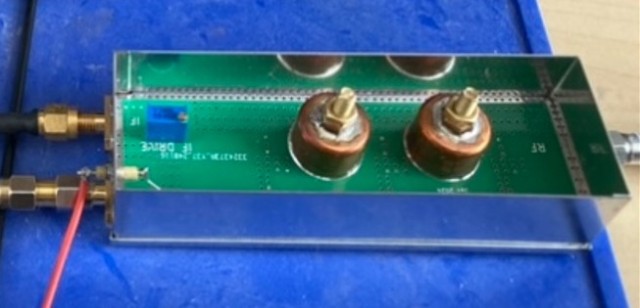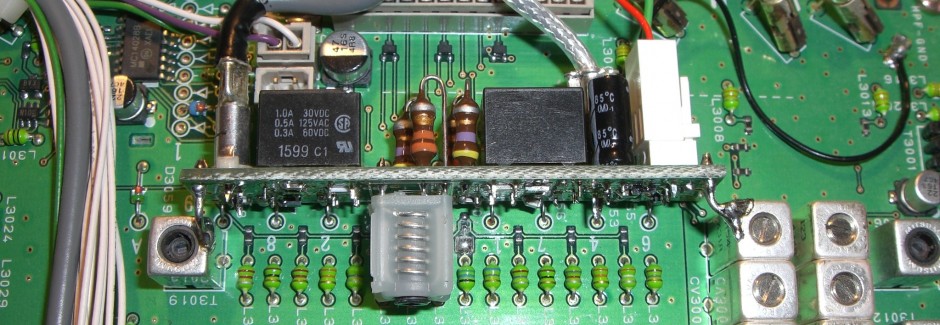 Having had success with the Rev2 LO boards the same design changes were applied to the TX Up-Converter board and another order placed on JLCPCB. I prepared the two ½” Pipe Cap filters, drilled the holes in the two side sections of the enclosure and soldered them together ready for the arrival of the new boards. The first board went together quickly and without any issues.
Having had success with the Rev2 LO boards the same design changes were applied to the TX Up-Converter board and another order placed on JLCPCB. I prepared the two ½” Pipe Cap filters, drilled the holes in the two side sections of the enclosure and soldered them together ready for the arrival of the new boards. The first board went together quickly and without any issues.
 With the LO module connected and the HP432A power meter connected a little (0dBm) 144MHz drive was applied and the filters adjusted for maximum RF out. This was done without the top and bottom covers in place. When I came to fit the bottom cover I detected some output without any 144MHz input! The cover / metal enclosure was causing some instability. Fortunately this was easily resolved by glueing a retangular piece of RAM to the cover.
With the LO module connected and the HP432A power meter connected a little (0dBm) 144MHz drive was applied and the filters adjusted for maximum RF out. This was done without the top and bottom covers in place. When I came to fit the bottom cover I detected some output without any 144MHz input! The cover / metal enclosure was causing some instability. Fortunately this was easily resolved by glueing a retangular piece of RAM to the cover.
 The 10368MHz output level was checked while the 144MHz drive level was changed. They both tracked nicely as the stepped attenuator on the IF input was adjusted in 1dB increments. The setup was producing +5dBm output which I was happy with. However on checking the LO leakage (at 10224MHz) it was found to be only -37dBc. This needed to be improved, either by adding additional filtering, changing the IF frequency, or maybe even both.
The 10368MHz output level was checked while the 144MHz drive level was changed. They both tracked nicely as the stepped attenuator on the IF input was adjusted in 1dB increments. The setup was producing +5dBm output which I was happy with. However on checking the LO leakage (at 10224MHz) it was found to be only -37dBc. This needed to be improved, either by adding additional filtering, changing the IF frequency, or maybe even both.
As the FT-818 covers 432MHz I decided to opt for this as the IF. The ADF4351 + SynthShield was changed to generate the new 3312MHz output. The LO board was then tweaked to work with 3312MHz input and 9936MHz output.
The output from the ADF4351 looked to be okay. The phase noise is still to be checked.
With this change to a 432MHz IF the LO leakage (at 9936MHz) was measured at -50dBc.
Here the two Up-Converter modules are all boxed up and under test.
What’s Next:
- Put together the ancillary modules (sequencer, Voltage regulators etc) and try to best guess the layout and size of a suitable enclosure to house everything.
- Make use of one of the popular “Franco Boards” to create a small 100mW PA.
- Undertake further measurements and tests to ensure the modules are not producing any “undocumented surprises” 🙂
Acknowledgements:
- Paul Wade, W1GHZ for sharing his ideas, experience and encouragement to inspire people to have a go and try the GHz bands.


